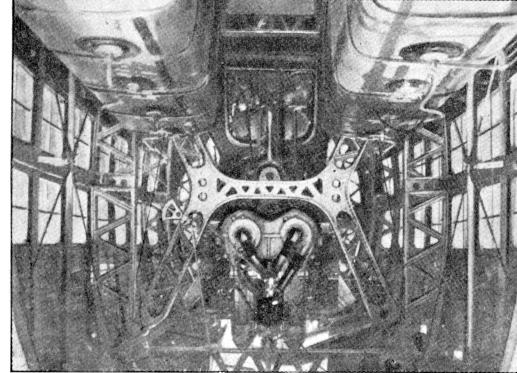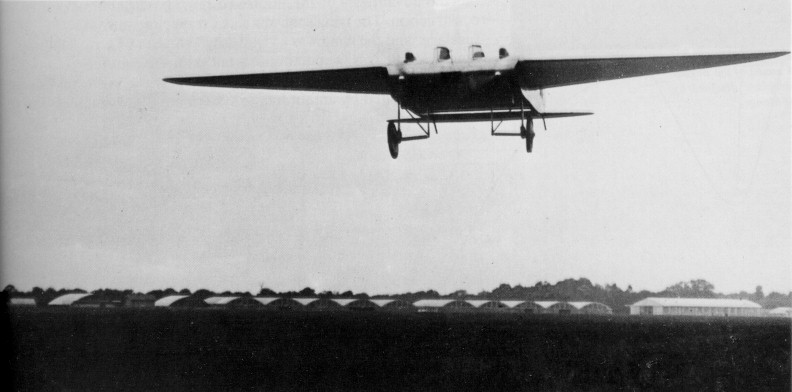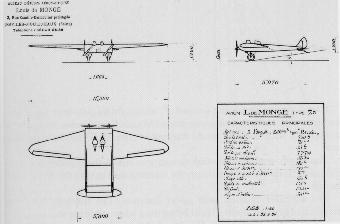

Editor: Jaap Horst

Function: Fighter
Year: 1918, Crew: 2 Engine: 1 x 450HP Bugatti
Wing Span: 11.73m, Length 8.34m, Height 2.77m
Max Weight: 1770kg, Speed: 225km/h
Armament: 3 x mg 7.7mm
Two types of Leviathan were known, the first of which is shown at the top of the page. These Aircraft were based on the "Engine-room concept", which was first mentioned by Jules Verne!! The idea was to put multiple engines in one engine room (making on-flight maintanance possible!!) driving two - counter - rotating propellors (note that this same idea is followed in the Bugatti 100P/110P). The idea was not entirely new, and had been used in both a German Bomber plane in WWI, where 6 engines within the Fuselage were used to drive four propellors, and in a "Macchi" that attained a record-speed of 709 km/h. This was the Macchi M.C.72 seaplane. It was powered by the Fiat AS.6
engine, wich consisted of two coupled AS.5 V-12 engines, driving
co-axial contra-rotating two-bladed propellers. The AS.6 delivered
2800hp, and for the record attempt the engine was boosted to 3100hp!.
The first plane of 1920 possessed the twin-U16 and in a French book it was said to have four 250HP Bugatti engines. In practice this was true, as each bank of eight cylinders could be declutched. There's an interesting little detail about this book by R. Marchal. I found it in the library-computer and thought I might find something in it, either on the Bugatti or the Breguet, so I ordered it. When I began reading, I noted that the book had not been cut, so all pages were connected still, on the outside, making it impossible to read. So in 50 years in the library, nobody had read this book! The pictures of the Leviathan are from this one. Below one can see the interior of the plane, with the back of the rear U16 engine. The rear engine is the highest of the two, the gearing is inbetween the two engines, and the driveshafts for the propellors go inbetween the cylinder banks of the front engine!
A second Leviathan (type 21) was constructed in 1921. Some sources state that this had actually the H-32 (Quadrimoteur type B) engine, but this does not fit with the time the engine was first shown, in 1924. It was most probably the double U-16 (Quadrimoteur type A). It flew on June 30, 1922, achieving an altitude of 2000ft (650m). After this run the engine had ran for a total of 70hours, on bench and air, a record for Bugatti Aircraft engines! That November, at the Grand Prix des Avions de Transport, one bank of 8 cylinders failed, enabling it to show the possibility of the plane, to fly with 75% of the power. Unluckily then an other bank failed as well, and the aircraft was forced to the ground. It was never any succes.
This still was not a real success, and the engines were changed for Lorraine-Dietrich's. These were not much more reliable, and in the 1923 Grand-Prix the plane crashed and burned due to engine failure.
Breguet Type 20 and 21, Leviathan, 1920 and 1921
See the picture at top of page!
In 1920 Scientific American foresees that this kind of construction is bound to become common, once large planes are introduced on a large scale, and there is an urgent demand for reliability. Each engine was to have a clutch, so it could be switched off and serviced in flight.
Breguet Type 22
Disappointed by the engine-room concept, Breguet produced a "normal" two propellor biplane. On each side of the fuselage was a U16 Breguet-Bugatti, driving a propellor. Still a bank of 8 cylinders could disengage itself in case of failure, enabling the propellor to run with at least half power. The engines outside the fuselage increased the usability, as noise and fumes from the payload space were eliminated. Passenger capacity was increased to twenty.
De Monge Typ 7.5
This actually was a scale model for a "flying wing" design by Louis de Monge (who later designed the 100P Bugatti). It was equipped with two Brescia engines. The full size plane was never realised.


Read on about this aircraft in the next issue of the Bugatti revue !
Become a member of the Bugatti Aircraft Association!